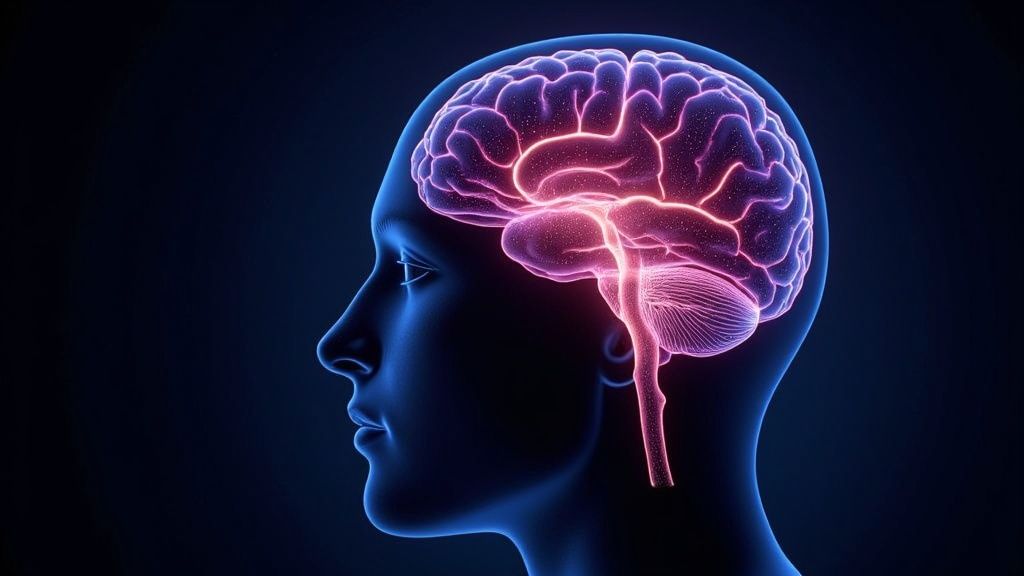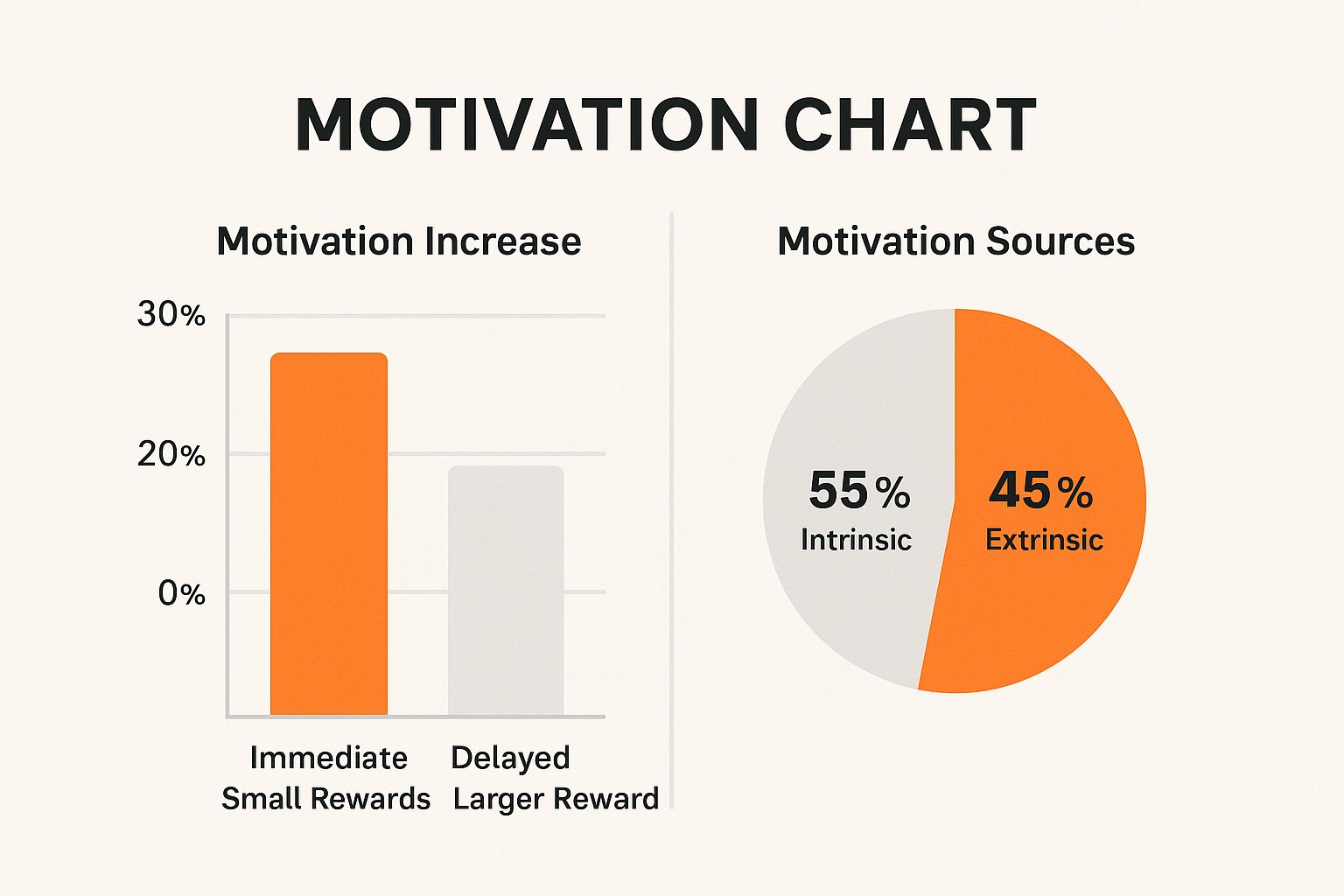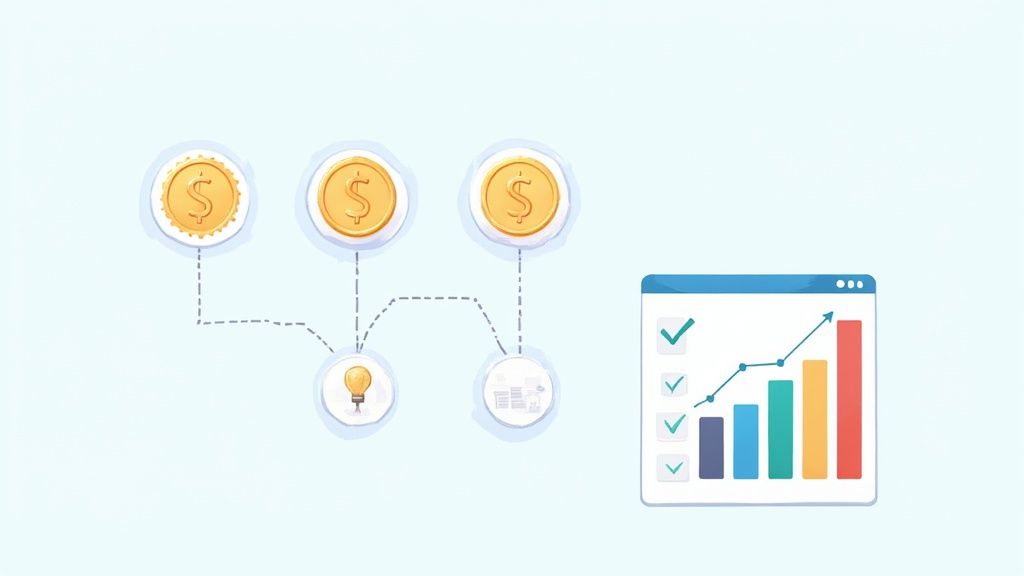Reward Psychology: Boost Motivation & Change Behavior
The Neuroscience Behind Your Brain's Reward System

At the heart of our motivation lies a complex interplay of biological processes within the brain. This intricate network, known as the reward system, holds the key to understanding reward psychology. A crucial component of this system is dopamine, a neurotransmitter often called the brain's "pleasure chemical." Dopamine generates a feeling of satisfaction when we accomplish a goal or enjoy a pleasurable experience.
This sense of reward is not random; it's a product of evolution, ensuring our survival. Essential activities like eating and procreation trigger the release of dopamine, reinforcing these behaviors. However, not all rewarding activities are inherently enjoyable.
Many activities require extrinsic motivation, meaning we are driven by external factors such as praise or tangible rewards. This distinction highlights the complex nature of reward psychology and how susceptible it is to influence.
The Role of Dopamine
The discovery of the brain's reward system marked a significant advancement in the field of reward psychology. In 1954, James Olds and Peter Milner made a groundbreaking discovery known as intracranial self-stimulation. They observed that rats would repeatedly press a lever to receive electrical stimulation to specific brain areas.
The rats' behavior was so compelling that they would press the lever thousands of times per hour, even to the point of exhaustion. This highlighted the profound impact of reward on behavior. This discovery led to the understanding that stimulating these brain regions induced pleasure, consistent with similar sensations reported by humans.
Subsequent research over the next two decades solidified dopamine's essential role in these reward pathways. Explore this topic further
Key Brain Regions Involved
The reward system is not confined to a single area; it involves a coordinated effort among several brain regions. The mesolimbic pathway, a crucial component, links the ventral tegmental area (VTA) to the nucleus accumbens.
The VTA releases dopamine, and the nucleus accumbens processes this signal, generating the feeling of pleasure and reward. The prefrontal cortex also plays a vital role in decision-making linked to reward-seeking behavior. It helps us assess potential rewards and select the best course of action.
Understanding the interplay of dopamine, key brain regions, and external motivators provides a valuable framework for grasping how reward psychology shapes our actions. This knowledge is especially relevant as our ancient reward systems constantly interact with modern environments. Read also: How to create gamification within your loyalty program These interactions can be positive, propelling us towards our goals, but they can also be harmful, potentially leading to addictive behaviors and other difficulties.
Why Your Past Rewards Control Your Current Attention
Have you ever noticed how you're drawn to certain advertisements or products, even if you don't really need them? This isn't a coincidence. It's your brain's reward system influencing your attention. Past experiences with rewards significantly impact what grabs your attention and what you perceive as valuable. Let's delve into how these unconscious biases develop and how they impact our everyday choices.
The Power of Past Rewards
Our brains are constantly in pursuit of rewards. They learn to prioritize stimuli linked to positive experiences. If a particular product or experience has led to a positive outcome in the past, your brain will automatically prioritize information related to it.
For instance, if you've enjoyed a specific brand of coffee, you're more inclined to notice their ads and may even crave their coffee, regardless of whether you consciously want it. This prioritization happens unconsciously, shaping your attention without you realizing it.
How Attentional Biases Work
This attentional bias is driven by dopamine, a neurotransmitter associated with pleasure and reward. When you experience a reward, dopamine is released, reinforcing the neural connections between that experience and feelings of pleasure. This creates a powerful feedback loop, making your brain more receptive to stimuli that predict similar rewards. As a result, your attention is unconsciously drawn to these stimuli, even if they're not aligned with your present goals.
This bias extends beyond consumer behavior. It influences various aspects of our lives, including learning, habit formation, and workplace motivation. Educators can utilize reward psychology to make learning more effective by associating educational content with positive experiences. Understanding these biases can also improve personal productivity by strategically linking tasks with rewarding outcomes.
The Role of Statistical Learning
Statistical learning and reward history are also key factors in attention control. They independently influence how we prioritize our attention. Research shows that both learned probabilities and past rewards contribute uniquely to how we focus, impacting performance in tasks like visual search. Discover more insights about this research.
Managing Your Reward-Driven Attention
While reward-driven attentional biases can be helpful, they can also be a hindrance. Understanding how they function is the first step toward managing their influence. By recognizing your personal reward-driven attention patterns, you can start to shift your focus toward what truly matters, instead of what simply provides immediate gratification. This awareness allows you to consciously choose where you direct your attention, leading to more fulfilling and productive results.
Expectation Vs. Reality: When Rewards Disappoint or Delight

The anticipation of a reward can be a powerful motivator. But sometimes, the actual reward doesn't quite live up to the hype. This difference between the expected reward and the actual reward is a key element of reward psychology, impacting both motivation and overall satisfaction.
The Power of Surprise
Unexpected rewards can be incredibly motivating. They create a surge of dopamine, reinforcing the behavior that led to the reward. This happens because our brains are always trying to predict what will happen next, including the possibility of rewards. When a reward appears unexpectedly, it disrupts these predictions, creating a prediction error. This error tells the brain to update its understanding of the world, which strengthens the link between the action and the unexpected reward. As a result, unexpected rewards can make us want to repeat the rewarded behavior.
For instance, imagine receiving an unexpected bonus at work. This surprise is likely to boost your morale and encourage you to continue performing well. This contrasts with predictable rewards, which, while appreciated, can quickly become less motivating.
The Importance of Prediction Errors
Our brains use these prediction errors to constantly update their reward predictions. This updating process is essential for learning and adaptation. When a reward consistently matches expectations, the prediction error decreases, and the motivational impact of the reward diminishes. This explains why predictable rewards can eventually lose their effectiveness.
Furthermore, reward expectations and outcomes strongly influence motivation and behavior. Studies on reward-guided behavior have shown this connection. For example, a study found that monkeys reacted strongly to cues indicating both large rewards and significant penalties, highlighting that motivation can arise from both seeking rewards and avoiding punishment. This illustrates the complex relationship between reward and risk in decision-making. Explore this topic further
Managing Expectations
Understanding the role of expectation in reward psychology provides valuable insights for setting goals, boosting workplace motivation, and forming strong habits. By managing expectations effectively, you can create reward systems that remain motivating without needing constantly increasing incentives. Toki, a loyalty platform for Shopify merchants, understands these principles. It helps businesses design engaging reward systems that encourage repeat customers. Features such as tiered memberships, points-based rewards, and personalized campaigns allow brands to leverage reward psychology to build strong customer relationships and boost sales.
This means focusing on the element of surprise and strategically using unexpected rewards can greatly enhance motivation and reinforce desired behaviors. Understanding how prediction errors influence our responses to rewards provides a foundation for creating effective and sustainable reward systems in both personal and professional settings.
Harnessing Reward Psychology for Learning & Habit Formation
Understanding reward psychology is crucial for effective learning and establishing lasting habits. This involves recognizing the distinct roles of intrinsic rewards (inherent satisfaction) and extrinsic rewards (external motivators), and how they interact.
Intrinsic vs. Extrinsic Rewards
Intrinsic rewards stem from the inherent enjoyment of an activity itself. For example, a child might find joy in drawing simply for the pleasure of creating. Extrinsic rewards, on the other hand, come from external sources, such as praise, grades, or prizes. A student might study diligently to earn a good grade, even if the subject matter doesn't hold their interest.
While both types of rewards can motivate, finding a balance is key. Over-reliance on extrinsic rewards can sometimes diminish intrinsic motivation. If the external reward is removed, the individual may lose interest altogether. This highlights the importance of cultivating intrinsic motivation whenever possible.
The Power of Reward Schedules
The timing and frequency of rewards, known as reward schedules, significantly influence habit formation. Different schedules produce different results. Immediate rewards offer a quick motivational boost, while delayed gratification fosters perseverance and strengthens habits. For example, a small, immediate reward could increase motivation by 30%, while a larger, delayed reward might only increase it by 20%.
Fixed rewards (given after a set number of responses or time interval) are predictable and can lead to rapid initial learning. However, motivation can quickly wane if the reward ceases. Variable rewards (given unpredictably) create a stronger sense of anticipation and are more resistant to extinction. This is the underlying principle behind slot machines and many mobile games.

The infographic above illustrates the impact of reward timing on motivation and the interplay between intrinsic and extrinsic motivation. Immediate rewards offer a greater short-term boost, but intrinsic factors remain the primary driver of overall motivation. For further reading on rewards and motivation, you might find this article helpful: Why your Shopify loyalty program isn't working and how to fix it.
To further explore the nuances of reward schedules, let's look at a comparison table. This table outlines the different types of reward schedules, their applications, limitations, and effectiveness in forming habits.
Comparison of Reward Schedules in Learning
| Reward Schedule Type | Description | Best Applications | Limitations | Effectiveness for Habit Formation |
|---|---|---|---|---|
| Fixed Ratio | Reward given after a fixed number of responses | Tasks requiring repetitive actions, initial learning | Can lead to burnout, decreased motivation after reward stops | Moderate, best for initial stages |
| Variable Ratio | Reward given after a varying number of responses | Maintaining engagement, games of chance | Can be unpredictable, difficult to implement consistently | High, creates strong anticipation |
| Fixed Interval | Reward given after a fixed time interval | Regular tasks, predictable deadlines | Can lead to procrastination, decreased motivation outside reward periods | Low, predictable and easily extinguished |
| Variable Interval | Reward given after a varying time interval | Encouraging consistent effort, pop quizzes | Can be unpredictable, difficult to implement consistently | Moderate, promotes steady engagement |
This table provides a clear overview of how different reward schedules can be applied. Understanding these nuances can be particularly helpful in designing effective learning strategies.
Practical Applications
By understanding these principles, educators, parents, and self-learners can design more effective strategies. Educators can utilize variable rewards to maintain student engagement, while parents can nurture intrinsic motivation by encouraging children to pursue activities they genuinely enjoy.
Ultimately, effectively using reward psychology involves understanding the interplay between intrinsic and extrinsic rewards, employing appropriate reward schedules, and tailoring approaches to individual needs. This fosters long-term motivation, promotes sustained effort, and facilitates the formation of beneficial habits.
Transforming Workplace Motivation Through Reward Psychology

Beyond traditional bonuses and "Employee of the Month" awards, reward psychology offers a deeper understanding of what truly motivates employees. Progressive organizations are moving away from generic reward systems and adopting strategies rooted in scientific research to improve both engagement and performance. This shift is fueled by the understanding that a single approach to rewards rarely works for everyone.
Personalized Motivation: A Key To Success
Why do some reward programs fail? A key reason is the lack of personalization. A generic reward system can actually demotivate employees if the incentives don't align with their individual values. For example, public recognition might be uncomfortable for an introverted employee, while a bonus might not resonate as strongly with someone driven by a sense of purpose.
Understanding how different personalities respond to various incentives is crucial for developing effective reward strategies. This is where personalized motivation becomes essential. By tailoring rewards to individual preferences and values, organizations can significantly increase their impact.
This personalization might involve offering a range of reward options, allowing employees to choose what best suits them. It could also involve creating individualized reward pathways based on personal goals and career aspirations. This not only boosts motivation but also fosters a sense of autonomy and ownership, further increasing engagement.
The Power of Purpose-Driven Rewards
Traditional rewards often focus on external motivators like money or recognition. However, purpose-driven rewards, which connect to an employee's sense of meaning and contribution, can tap into more powerful motivational drivers. This could involve recognizing employees' contributions to a company-supported social cause or offering professional development opportunities aligned with their passions.
These rewards cultivate a sense of fulfillment and purpose, leading to increased job satisfaction and long-term commitment. Furthermore, the structure of the reward system itself plays a vital role. While gamification can be effective by introducing elements of fun and competition, it can also backfire if poorly implemented. If the game mechanics feel forced or the rewards are trivial, gamification can actually decrease motivation.
Let's explore the effectiveness of various reward types in the following table:
Effectiveness of Different Workplace Reward Types
This table presents data on how different types of workplace rewards impact employee motivation, performance, and retention.
| Reward Type | Impact on Immediate Motivation | Impact on Long-term Performance | Employee Preference Rating | Implementation Complexity |
|---|---|---|---|---|
| Monetary Bonus | High | Medium | High | Low |
| Public Recognition | Medium | Low | Medium | Low |
| Professional Development Opportunities | Medium | High | High | Medium |
| Purpose-Driven Rewards (e.g., social cause contribution) | High | High | Medium | Medium |
| Gamified Rewards | Medium | Medium | Medium | High |
As you can see, different reward types have varying levels of effectiveness across different areas. Monetary bonuses provide a strong initial boost but may not sustain long-term performance. Professional development and purpose-driven rewards show promising results for long-term performance and are highly valued by employees.
Creating Sustainable Motivation
The ultimate goal of reward psychology isn't just to create temporary compliance; it's to cultivate sustainable motivation. This requires a shift from extrinsic to intrinsic rewards. By fostering a work environment where employees feel valued, challenged, and empowered, organizations can cultivate intrinsic motivation that drives sustained performance. This might involve providing opportunities for skill development, offering autonomy and flexibility, or fostering a sense of community and purpose in the workplace.
You might be interested in: The Psychology of Loyalty: Why Customers Buy Again and Again. It explores similar principles of reward psychology applied to customer loyalty, which can help businesses develop more effective customer retention strategies.
Finally, recognizing and avoiding common pitfalls is crucial for creating successful reward programs. Rewards that are seen as unfair or arbitrary can create resentment and decrease motivation. Similarly, rewards that are too easy to obtain lose their value, while those that are too difficult to achieve can lead to frustration and disengagement. Striking a balance between challenge and attainability is essential. By avoiding these pitfalls and integrating the principles of reward psychology, organizations can create reward systems that drive sustained motivation, enhance performance, and foster a positive and productive work environment.
When Rewards Go Wrong: The Psychology of Addiction
The human brain's reward pathways are essential for motivation and learning. However, these same pathways can be susceptible to manipulation, leading to addiction. This exploration delves into the delicate balance between healthy reward-seeking and the destructive nature of dependency. We'll examine why some rewards are more addictive than others, the development of tolerance, and the factors that make certain individuals more vulnerable to reward-related disorders.
The Allure of Certain Rewards
Some rewards are especially likely to trigger addictive behavior. These often involve substances or activities that produce a rapid, intense surge of dopamine, the neurotransmitter associated with pleasure. This surge creates a powerful sense of euphoria that can be extremely difficult to resist. For example, drugs like cocaine and heroin directly affect dopamine regulation, amplifying the reward signal.
Similarly, behaviors like gambling can create a rush of excitement and anticipation, also driven by dopamine release. This intense dopamine release reinforces the behavior, intensifying the individual's craving for the reward. A vicious cycle then develops where the individual seeks the reward not just for pleasure but also to relieve the discomfort of withdrawal.
The Development of Tolerance
Repeated exposure to potent rewards leads to tolerance. The brain adapts, requiring increasingly larger doses or more frequent engagement to achieve the same effect. This happens partly because dopamine receptors become less sensitive and partly due to changes in other neurotransmitter systems. As a result, the individual needs more of the reward to experience the same level of pleasure they once did.
This escalating need can have significant negative consequences, impacting relationships, finances, and overall well-being. It's a defining characteristic of addiction, demonstrating the powerful grip certain rewards can have on the brain.
Vulnerability to Addiction
While the intense dopamine response is a key factor in addiction, individual vulnerability also plays a role. Genetic factors, environmental influences, and pre-existing mental health conditions can all increase the risk of developing a reward-related disorder. Some individuals may be genetically predisposed to addiction, while others might develop addictive tendencies due to stressful experiences or trauma.
Digital Technologies and Addiction
The rise of digital technologies presents new reward-related challenges. Many apps and platforms utilize variable reinforcement schedules, much like those used in gambling. These schedules deliver rewards unpredictably, fostering a sense of anticipation and driving compulsive engagement. This explains why social media notifications, mobile games, and even online shopping can become addictive.
Substance vs. Behavioral Addictions
Substance and behavioral addictions share striking neurological similarities. Both involve disruptions in the brain's reward system, leading to compulsive behavior despite negative consequences. The underlying mechanisms are often the same, regardless of whether the addiction involves a chemical substance or a specific activity. This understanding emphasizes the importance of treating behavioral addictions with the same level of seriousness as substance addictions.
Maintaining a Healthy Relationship with Rewards
Maintaining a healthy relationship with rewards requires recognizing the potential for addiction and implementing strategies to mitigate risk. This includes setting limits on engagement with potentially addictive activities, seeking support from friends and family, and developing healthy coping mechanisms for stress and negative emotions. Recognizing early warning signs, such as increasing tolerance or withdrawal symptoms, is vital for preventing addiction before it takes hold.
For businesses seeking to build customer loyalty ethically, Toki offers a solution. Toki provides a platform for creating engaging reward programs that emphasize genuine value and long-term customer relationships. It empowers businesses to harness the power of reward psychology responsibly, avoiding the pitfalls of addictive design. Features like tiered memberships, personalized rewards, and community-building tools help create sustainable loyalty programs that benefit both the company and its customers.